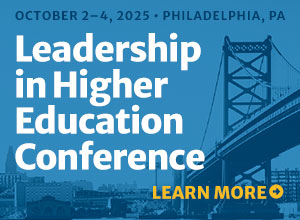Transitioning from Compliance to Innovation
Creating a culture for continuous improvement with academic programs is a challenge. As my institution—Sul Ross State University in Alpine, Texas—prepared for our decennial accreditation review, I found it difficult to motivate faculty to complete the required program reviews for the compliance report. With some cajoling, 41 faculty reluctantly agreed...
Gaining Cred: Why Universities Should Embrace Micro-Credentialing
I’ll confess, when I first heard about digital badges in the early 2000s, I thought they were kind of silly. I was just starting my career as an instructional systems designer (ISD)—the original title for learning designers. While I had fond memories of my Girl Scout sash, peppered with badges,...
Combat Declining Enrollment with In-Demand Niche Programs
Declining enrollment is a problem in higher education, and it’s only going to get worse. As Nathan Grawe explains in his book “Demographics and the Demand for Higher Education,” when the economy slowed in 2008, many families postponed having children—which means that, starting in 2026, there will be several years...
Providing Leadership and Support to Professionally Develop Adjunct Faculty
Adjunct faculty may be the most overused and under-resourced groups of individuals in higher education. Many departments and courses would not function, or at least not function well, without adjunct faculty. Yet despite being in many cases essential members of a department, adjuncts receive modest pay, typically by the course...
The Value of Cross-Discipline Networking
For more articles like this, check out an Academic Leader subscription or a free three-week trial! New teachers often teach the way they were taught. Give or take a few workshops or online training courses about writing learning objectives or understanding the LMS, many of us have found our way by observing, trying,...
How to Encourage Faculty to Adopt Open Educational Resources
The growth of open educational resources (OER) may prove transformative in the way online learning has been. Textbook costs have skyrocketed to the point that finding an alternative is no longer simply an issue of saving students money but of preserving educational outcomes as students forgo textbooks they cannot afford....
When the End Is in Sight
There comes a time in the life of an academic program when it is no longer viable due to dropping enrollments, lack of faculty resources, budget cuts, changing external contexts, or other factors. When the decision is made to close a program, the department chair’s attention to planning will be...
Myths and Beliefs That Limit Effectiveness of Higher Education
In an era promoting the science of learning, it is difficult to accept the continuation of myths and beliefs that undermine both student learning and academic institutions’ effective performance. Nevertheless, it is part of the human condition that groups and organizations, as well as societies, create myths that support a...
Online Education Data: What Are You Measuring, and How Are You Using It?
Higher education is becoming more data driven, including in relation to online education. The information that colleges and universities are collecting about online education could be institutional data used in accountability reports or accreditation reviews. It could also include data related to teaching online courses, learning management system usage, and faculty...
STEM Fatigue
For a little more than a decade, the STEM disciplines (science, technology, engineering, and mathematics) have been enjoying something of a privileged status at American colleges and universities. While enrollments in some other areas are stagnant or declining, they have been rising steadily in many STEM courses. In state systems,...












